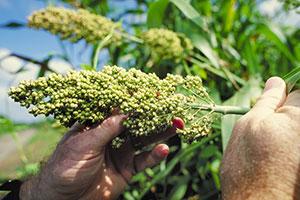The U.S. Grains Council (USGC) has ramped up its sorghum promotion work in Peru because that market is seeing both a significant discount to corn and can now import unlimited quantities of U.S. sorghum duty-free under the existing U.S.-Peru free trade agreement.
A small group of USGC representatives from the Washington, D.C., and Western Hemisphere offices visited the country last month and will follow up with another visit next week.
While there recently, they had the opportunity to engage end-users, processors, merchandisers, traders and government officials in conversations about the benefits of U.S. sorghum adoption. They also discussed market conditions and U.S. sorghum’s competitive advantage.
As the fifth largest importer of U.S. corn, Peru’s growing meat, milk and egg production make it an ideal location for new products, specifically distiller’s dried grains with solubles (DDGS) and sorghum. Starting Jan. 1, the duty and quota restrictions on U.S. sorghum have been lifted under the FTA, and a recent port expansion in Callao adds increased interest to the market.
Despite being in the infancy stages for sorghum adoption, Peru shows potential that USGC is aiming to develop through direct market promotion.
“We’re trying to change comfort levels,� said Alvaro Cordero, USGC manager of global trade, based in Washington. “We were able have discussions with traders and end users about their current practices and give presentations on what makes U.S. sorghum unique.�
Imports are expected to increase in Peru as knowledge continues to grow and discounts for the grain remain competitive. USGC continues to increase efforts in this area by working to improve market information, implementing hands-on training opportunities with end-users, visiting buyers and sellers and contacting U.S. suppliers.
“Trading houses are now looking into sorghum and consulting with their counterparts in the U.S. as they previously had not been tracking sorghum,� Cordero said. “We were able to immediately provide more updated data about the differences between sorghum in the U.S. and other countries.�
Cordero hopes that current prices and changing weather patterns in Argentina and Brazil will lead buyers in Peru to consider U.S. sorghum as a first choice. The main barrier to sorghum imports in Peru is attitudes shaped by negative experiences nutritionists there have had with non-U.S. sorghum.
“Sorghum from other origins has had anti-nutritional characteristics and condensed tannins that affected field results in agribusiness,� said Dr. Carlos Lopez a researcher at Universidad Autónoma de México who accompanied the team to Lima.
The recent outreach complements workshops held in Lima and Trujillo just a month ago on procurement, logistics and nutrition for DDGS and sorghum in poultry and cattle. More than 80 end-users, nutritionists and importers attended the event to update their knowledge on both commodities.
Over the years, USGC has had significant success with sorghum industry programs, including duck feeding trials in China, fish feeding trials in Vietnam and ethanol and pet food trials in Mexico.
To learn more about the Council’s efforts in Peru, click here.


